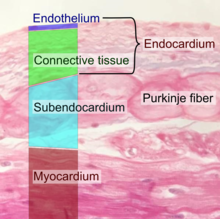Endocardium
| Endocardium | |
|---|---|
 Interior of right side of heart | |
| Details | |
| Identifiers | |
| Latin | endocardium |
| MeSH | D004699 |
| TA98 | A12.1.05.001 |
| TA2 | 3962 |
| FMA | 7280 |
| Anatomical terminology | |

The endocardium (pl.: endocardia) is the innermost layer of tissue that lines the chambers of the heart. Its cells are embryologically and biologically similar to the endothelial cells that line blood vessels. The endocardium also provides protection to the valves and heart chambers.[1]
The endocardium underlies the much more voluminous
Function

The endocardium, which is primarily made up of endothelial cells, controls myocardial function. This modulating role is separate from the homeometric and heterometric regulatory mechanisms that control myocardial contractility.[3] Moreover, the endothelium of the myocardial (heart muscle) capillaries, which is also closely appositioned to the cardiomyocytes (heart muscle cells), is involved in this modulatory role.[4] Thus, the cardiac endothelium (both the endocardial endothelium and the endothelium of the myocardial capillaries) controls the development of the heart in the embryo as well as in the adult, for example during hypertrophy. Additionally, the contractility and electrophysiological environment of the cardiomyocyte are regulated by the cardiac endothelium.[5]
The endocardial endothelium may also act as a kind of blood–heart barrier (analogous to the
Clinical significance
In
During depolarization the impulse is carried from endocardium to epicardium, and during repolarization the impulse moves from epicardium to endocardium. In
References
- PMID 1415782.
- PMID 31424779, retrieved 2023-02-23
- PMID 21989917.
- ^ "Endothelial Dysfunction". stanfordhealthcare.org. Retrieved 2023-02-23.
- PMID 8970576.
- PMID 30137840, retrieved 2023-02-23
- PMID 21169398.
- – via ahajournals.org.
- .
- PMID 29262146, retrieved 2023-02-23
- PMID 30335314, retrieved 2023-02-23
- PMID 30725879, retrieved 2023-02-23
External links
- Histology image: 64_06 at the University of Oklahoma Health Sciences Center - "Heart and AV valve" (atrial endocardium)
- Histology image: 64_07 at the University of Oklahoma Health Sciences Center - "Heart and AV valve" (ventricular endocardium)
